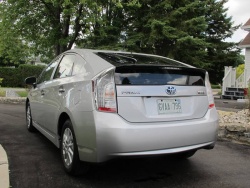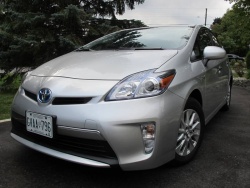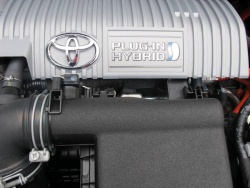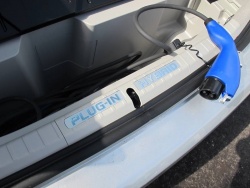 2012 Toyota Prius PHV Plug-in Hybrid. Click image to enlarge |
|
Comparison Test: Best Fuel-Efficient Cars
Manufacturer’s web site |
Review and photos by Paul Williams
Photo Gallery:
2012 Toyota Prius PHV
It’s taken a decade or so, but hybrid vehicles are becoming commonplace on Canadian roads. The Toyota Prius is the easiest to spot; its distinctive triangular profile is almost synonymous with “alternative” vehicles.
Toyota recently added variations on the Prius theme in the form of a Prius C subcompact and a Prius V wagon. The latest version, however, refines the hybrid powertrain by enabling owners to supplement power by plugging it in.
Starting at $35,700, the 2012 Prius PHV is basically a tried-and-true hybrid Prius five-door “liftback” loaded with desirable features including automatic climate control and navigation, but with the additional ability to plug into your standard 120V or 220V outlet. Doing so will charge its new lithium-ion battery, enabling you to drive for about 20 km gasoline-free.
The new hybrid battery is rated at 4.4 kWh, a size, according to Toyota Canada, “which reflects packaging constraints, weight (and thus fuel efficiency as a hybrid), charging times and cost.” Toyota estimates that 75 percent of people commute less than 25 km per day, and this has also factored into determining the battery specifications.
 2012 Toyota Prius PHV Plug-in Hybrid. Click image to enlarge |
Lest you think 20 km is not very much, compare it with the standard Prius, which maybe can manage a kilometre or so at low speeds in specific driving conditions. The Prius PHV will run in EV mode at speeds up to 100 km/h, so in range and speed this is a significant and potentially useful advance.
The 2012 Prius PHV is one of the first plug-in hybrids to market, although several manufacturers are currently releasing new models or plug-in versions of existing models this year. Pre-production versions of the Prius PHV have been displayed at international car shows and circulating among journalists since 2010, local battery producers and shops have been converting standard Priuses to plug-in versions for nearly as long, and the only surprise is that it has taken this long for Toyota to get this vehicle to market.
Now that it’s here, why should consumers be interested in going “plug-in?”
As I wrote in a previous Autos.ca article, hybrid vehicles are being challenged in fuel consumption, power, and emissions by newly developed gasoline direct injected engines. Additionally, such vehicles typically cost less than hybrids.
In order for vehicle manufacturers to improve the performance of their hybrid vehicles, they have developed more efficient batteries and the long-awaited plug-in option. Also, we’re seeing the price of hybrid vehicles come down. These developments are logical steps in the evolution of hybrid technology.
   2012 Toyota Prius PHV Plug-in Hybrid. Click image to enlarge |
Going “plug-in” can have real benefits in relation to fuel consumption and emissions (in electric vehicle mode there are no tailpipe emissions), and for the time being, at least, many provincial governments are offering generous financial incentives when purchasing new EVs or PHVs. In the case of Ontario, for instance, a $5,000 rebate is offered upon purchasing a Prius PHV, reducing its base price to $30,700, which is only $850 more than the similarly equipped non-plug-in Prius Touring. You also get to use the new “green” licence plate that allows unrestricted access to HOV lanes here in Ontario.
The “base” 2012 Prius PHV arrives with numerous desirable standard features, including Bluetooth, streaming audio, navigation, Smart Key system with push-button start, backup camera, auto-dimming rear-view mirror, cruise control, 15-inch alloy wheels, heated mirrors, satellite radio, and SMS-to-speech/email-to-speech capability.
For an extra $5,235 you can add the Technology Package, which includes premium navigation, a pre-collision system, power driver’s seat, “softex” simulated leather seating, dynamic radar cruise control, LED headlamps with auto-leveling sensor, headlamp washers, and fog lights.
The four-cylinder, 1.8L Atkinson cycle engine with Hybrid Synergy Drive makes 134 horsepower, and is the same system found in the standard Prius. Externally, the Prius PHV is likewise virtually the same as the standard Prius, except for the silver door handles, unique Prius Plug-in badges, silver trim front and rear, and blue tinted headlamp housings. However, the Prius PHV features a hybrid battery that can store much more power than the standard Prius battery.
Taking three hours to charge using normal household current, and 90 minutes using a 220V outlet, the system can be programmed in the vehicle to charge at off-peak times, thus further reducing costs. The charging system is activated simply by using the supplied charging cord that resides in a cargo area compartment.









